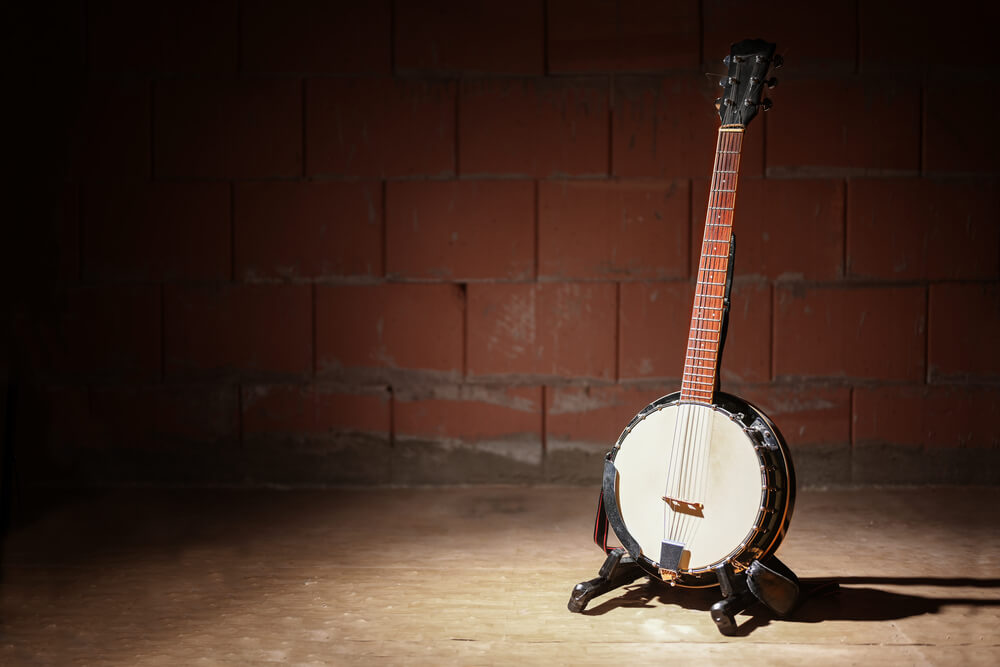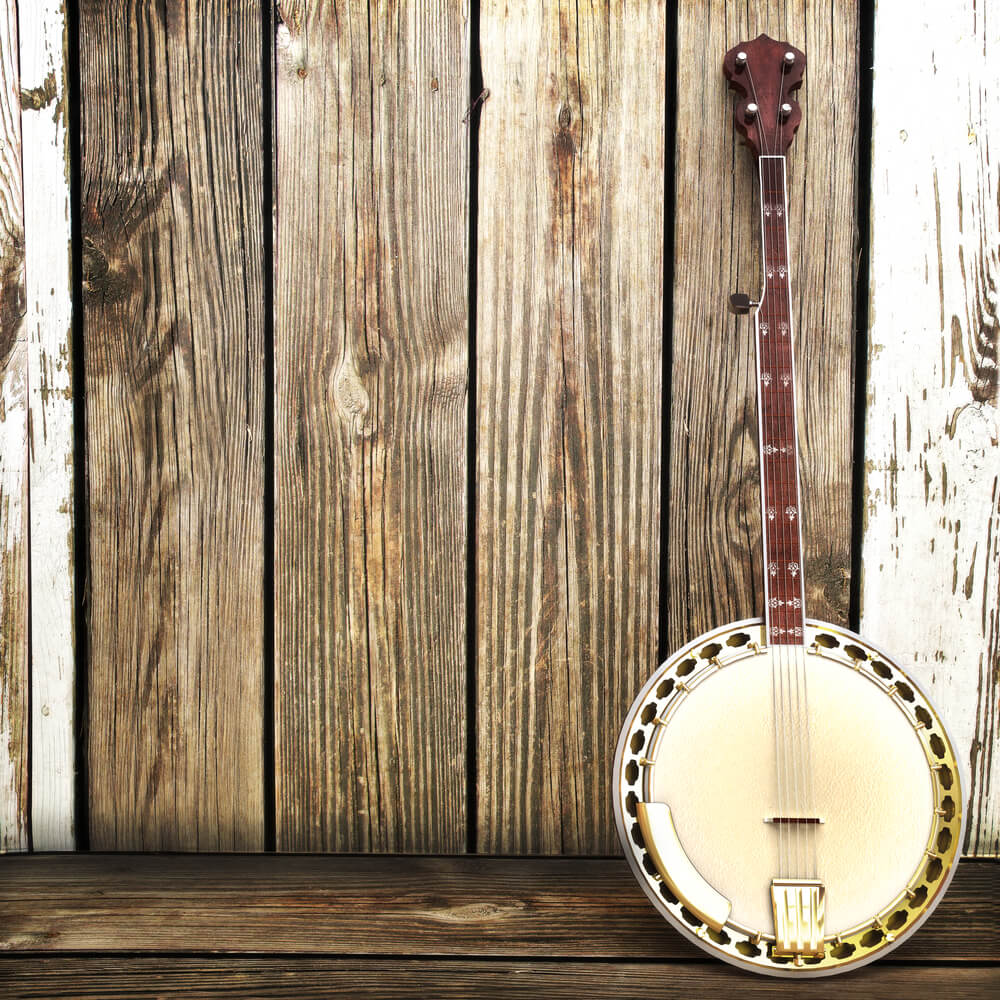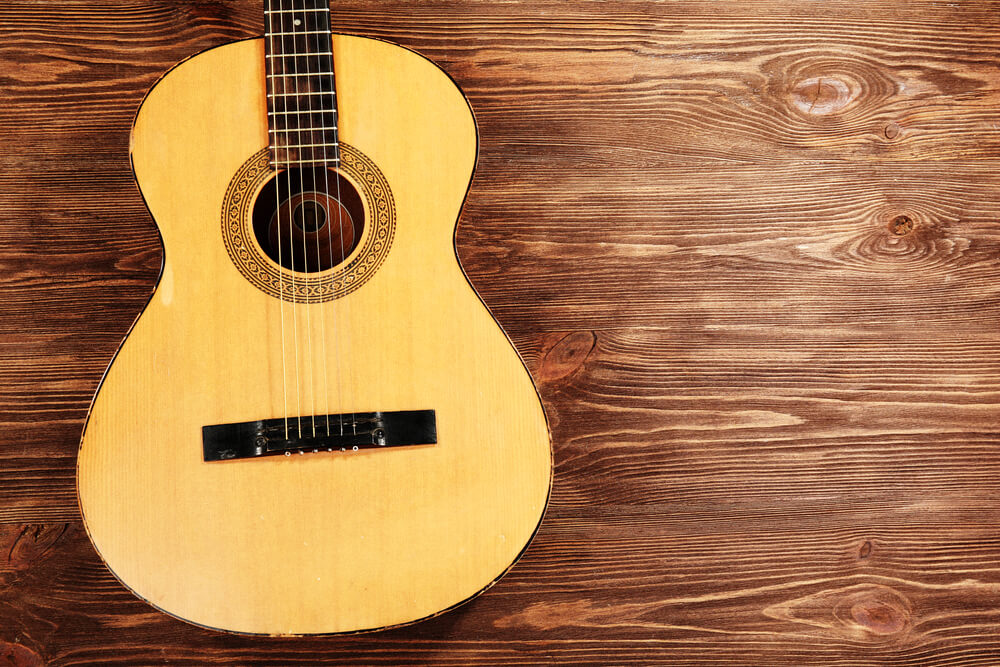When musical enthusiasts consider stringed instruments, banjo and guitar are popular choices. Each instrument boasts a unique history, design, and sound that appeals to musicians and music lovers alike.
Getting to know Banjo Vs Guitar: What’s The Difference could guide musicians in their instrument selection and broaden the audience’s appreciation for diverse music styles.
The banjo has its roots in African and American history, while the guitar has a rich European heritage.
The materials and design of these instruments also vary, with banjos using a drum-like resonator and guitar body shapes changing depending on the type of guitar.
Differences in strings and tuning further set these instruments apart.
Key Takeaways
- Banjo and guitar have distinct histories, designs, and materials.
- Variations in strings and tuning contribute to each instrument’s unique sound.
- Understanding the differences between banjo and guitar can help musicians choose an instrument and improve audience appreciation.
Banjo Vs Guitar: What’s The Difference
In my research, I have found that the banjo and guitar have distinct origins and histories. The banjo traces its roots back to Africa, while the guitar has a history that spans several continents and centuries.
The banjo’s earliest history can be found in West Africa, where instruments resembling the modern banjo were played by the local population.
These early instruments typically had a gourd body, a wooden neck, and gut or plant fiber strings. The banjo arrived in America through the transatlantic slave trade, and it was here that its unique sound and design were further developed.
By the early 19th century, the banjo had become a popular instrument in the United States, particularly among African-American communities and minstrel shows.
On the other hand, the guitar has a more complex history, with its origins likely stemming from the ancient stringed instruments of Persia and India.
These instruments eventually made their way to Europe through trade and cultural exchange. Over time, they evolved into various forms, such as the lute, which was popular during the Renaissance period.
The modern guitar emerged by the late 18th century, with the six-string Spanish guitar being the catalyst for its current design and popularity.
While banjo and guitar share some similarities, such as being fretted stringed instruments, they have distinct differences in construction, playing techniques, and musical genres.
The banjo typically features a round, drum-like body, and a shorter neck, while the guitar has a flat body and a longer neck. Banjo music often showcases lively and rhythmic patterns, whereas guitar music explores a wider range of musical styles and emotions.
The banjo and the guitar each have unique histories, designs, and sounds. By understanding their origins and development, we can appreciate the diversity of music that these two remarkable instruments have contributed to our world.
Distinctive Designs and Materials
I find that one major difference between banjos and guitars is their design and construction. Banjos usually have a round, drum-like body made of wood, metal, or plastic, while guitars have a hollow, hourglass-shaped wooden body.
The round body of banjos, known as the pot assembly, consists of a circular frame, a drumhead, and metal components. It produces a sharp, bright sound, which is ideal for styles like bluegrass and folk music.
On the other hand, guitars have a warm, resonant tone suitable for a wide range of musical genres.
Resonator banjos, a subtype of banjos, feature an additional metal cone inside the body known as the resonator. This resonator amplifies sound, giving these banjos a louder and brighter tone.
Guitars do not have resonators, relying mainly on the hollow wooden body for sound projection.
In terms of size, banjos are generally slightly smaller and lighter than guitars. They come in various configurations, such as 4-string, 5-string, and 6-string banjos.
Guitars, on the other hand, are standardized with 6 strings, although there are variants like the 12-string guitar and the bass guitar.
Another notable difference when it comes to materials is the type of wood used in construction. Banjos often use woods like maple, rosewood, or walnut for their necks and fingerboards.
In contrast, guitars often use woods like mahogany, rosewood, or maple for their necks and ebony, rosewood, or maple for their fingerboards. The choice of wood can significantly affect the instrument’s playability, weight, durability, and tonal characteristics.
As for cost, banjos vary widely in terms of price. Entry-level models can be found for as low as $100, while professional-grade banjos can go up to $3,000 or more.
Guitars also come in a broad price range, with beginner models starting at $100 and high-end professional models costing $5,000 or more.
There are several distinctive differences in design, materials, and construction between banjos and guitars. While both are versatile, stringed instruments used in various music styles, their unique features cater to specific tonal characteristics and playing techniques.
Types of Banjo and Guitar
As a musician, I have a good understanding of the various types of banjos and guitars available.
In this section, I will discuss the more common types of banjos and guitars you may come across.
Starting with banjos there are mainly two types: the five-string banjo and the four-string banjo. The five-string banjo is the most popular, featuring a shorter fifth string that allows for unique fingerpicking styles.
Bluegrass and old-time music are often played on these banjos. On the other hand, the four-string banjo is used mostly for jazz, Dixieland, and Irish music.
It is generally played with a pick in a strumming style. While these are the two main types, you may also find six-string banjos, which are hybrid instruments designed to mimic the feel of a guitar for guitar players.
Moving on to guitars, there are several types and sizes available, catering to different genres and playing styles. The acoustic guitar is one of the most common types, featuring a hollow body that resonates with the sound of the strings, producing a rich, warm tone.
It is versatile and used in various music genres, such as pop, folk, rock, and country.
The electric guitar is another popular type of guitar, which uses magnetic pickups to convert the vibrations of the strings into an electrical signal that gets amplified.
Electric guitars are ideal for genres such as rock, metal, blues, and jazz, as they produce a wide range of sounds through various effects and amplifiers.
The classical guitar, also known as the Spanish guitar or nylon-string guitar, has a wide neck and features nylon strings, providing a soft and warm tone. It is commonly used in classical music but also in other genres such as flamenco, Latin, and Brazilian music.
Lastly, the bass guitar is a low-pitched instrument that typically has four strings but can also have five or six. Its main role is to provide the rhythmic foundation and melodic structure within a band. Bass guitars can be found in various music genres, from rock and pop to jazz and funk.
In summary, there are several types of banjos and guitars available, each with their distinctive styles, sounds, and characteristics. Knowing the differences between them can help you decide which instrument is most suitable for your music preferences and playing style.
Strings and Tuning
When it comes to strings and tuning, there are some notable differences between banjos and guitars. As a musician, I’m interested in exploring these differences to understand the unique characteristics of each instrument.
In general, guitars have 6 strings, while banjos have either 4 or 5 strings. My 6-string guitar follows the standard tuning of EADGBE, which provides a wide range of chords and musical possibilities.
On the other hand, my 5-string banjo uses a unique open tuning called “open G” (gDGBD), allowing me to play chords by simply strumming it with no fretting required.
This open tuning lends itself to a different kind of playing style, creating the characteristic sound of the banjo.
Tuning a 4-string banjo can depend on the style of music being played, but one common tuning is the “Chicago style” or “guitar tuning,” which is DGBE, similar to the top 4 strings of a guitar.
This tuning makes it easier for me as a guitarist to transition between the two instruments.
For both banjo and guitar, it’s important to keep the strings in good condition. Bands around the strings may have different materials, which can affect the sound and feel of each instrument.
For example, my guitar has steel strings which create a bright and loud sound, while my banjo has a combination of steel and wound strings with a thinner texture for a crisp, twangy tone.
In conclusion, the number of strings and various tuning options for banjos and guitars can greatly impact the sound and playing style of each instrument.
As a musician, understanding these differences allows me to appreciate the unique qualities of both banjo and guitar, expanding my repertoire and creative possibilities.
Playing Techniques
When it comes to playing techniques, both the banjo and guitar have their own unique approaches. I’d like to briefly explore some of these differences, focusing on chords, strumming, fingerpicking, and plucking.
In terms of chords, the guitar allows for a wide variety of chord shapes and progressions due to its six strings and larger fretboard. This provides me with the ability to play many genres and styles.
On the other hand, the banjo typically has five strings, and its open G tuning lends itself well to certain styles like bluegrass and country.
Chord shapes on the banjo tend to be simpler, allowing for faster chord changes and emphasizing the melody over complex harmonies.
Strumming is a common technique on both instruments, but the approach can differ. On the guitar, I often use a pick to strum chords in various rhythmic patterns across all six strings, creating a full and rich sound.
With the banjo, I might focus on specific strings or utilize a technique called “rolling,” where individual fingers alternate between strings to create a continuous, flowing sound.
Fingerpicking, or using my fingers to pluck the strings, is also popular on both instruments. On the guitar, I usually employ my thumb, index, middle, and ring fingers to pick out intricate patterns, often combining chords and melody.
The banjo’s unique fifth string, which is shorter and higher pitched, adds an extra layer to fingerpicking patterns, utilizing the thumb in a technique called “clawhammer” or “frailing” to create a distinctive, driving rhythm.
Finally, plucking refers to pulling on a string with either my fingers or a pick, creating a clear and sharp sound.
While plucking is versatile and can be applied to both guitar and banjo, the banjo’s bright and resonant tone often lends itself better to this technique, emphasizing individual notes and adding a lively quality to the music.
While there are similarities in playing techniques between the banjo and guitar, the unique features of each instrument lead to distinct approaches in chords, strumming, fingerpicking, and plucking, offering a variety of soundscapes and styles for me to explore.
Sound Characteristics
When comparing banjo and guitar, it’s important to look at their sound characteristics to understand the differences between them.
Let me discuss the aspects in which their sounds differ.
The sound produced by a banjo has a bright, sharp, and crisp tone. This is primarily due to its construction, featuring a circular drum-like body with a skinhead that resonates with the vibrating strings.
It typically has a shorter sustain, creating a rhythmic and snappy sound. This characteristic sound made it popular in bluegrass, country, and folk music.
On the other hand, the guitar has a more versatile sound, ranging from mellow and warm tones to bright and crisp ones. It comes in various body shapes and materials, which can affect its sound characteristics.
Generally, guitars have a longer sustain, allowing chords and notes to linger and blend more seamlessly. This makes it suitable for various music genres, from rock and pop to jazz and classical.
In terms of volume, the guitar may produce softer or louder sounds depending on its construction, strings, and playing style. Acoustic guitars with larger and deeper bodies usually generate deeper, more resonant sounds.
Meanwhile, electric guitars can produce a wide array of sounds through the use of amplifiers and effect pedals.
Regarding the playing techniques, I find that the banjo is often played using fingerpicking or clawhammer style, giving it a rhythmic, plucky sound.
The guitar, however, offers more diverse playing techniques, such as fingerpicking, strumming, or flatpicking. This flexibility allows guitar players to create various sounds and styles.
To sum up, the banjo and guitar have distinct sound characteristics, making them suited for different types of music.
The banjo has a bright, crisp tone with a shorter sustain, while the guitar produces a more versatile sound with a broader range of sustain and playing techniques.
Genres and Playing Styles
In my experience, both banjo and guitar can be used in a variety of genres and playing styles, although they are more common in specific ones. Let me explain the different musical styles that these instruments typically shine in.
The banjo is commonly associated with genres like bluegrass, country, and folk music. This is because its bright and twangy sound complements the acoustic nature of these genres well.
Some popular banjo players in these genres include Earl Scruggs, who pioneered the three-finger picking style for bluegrass, and Pete Seeger, who is known for his contributions to American folk music.
On the other hand, the guitar’s versatility allows it to be featured in a much broader range of genres. In pop and rock music, the electric guitar is often at the forefront, with famous players such as Jimi Hendrix and Eric Clapton.
Jazz guitarists like Wes Montgomery and Pat Metheny have also made significant contributions to the genre with their smooth and intricate playing.
Blues guitar has a distinctive sound and playing style, popularized by legends like B.B. King, Stevie Ray Vaughan, and Muddy Waters. In classical music, the nylon-stringed classical guitar is utilized, with Andrés Segovia and Julian Bream being prominent performers in this area.
Despite these general differences, both banjo and guitar can be found in unexpected genres and styles. For instance, jazz banjo playing, also known as “Dixieland” style, dates back to the early 20th century, with players like Johnny St. Cyr and Danny Barker.
Conversely, guitars are sometimes used in bluegrass, country, and folk music, often played with the fingerpicking technique, which can create a similar feel to the banjo.
In summary, the banjo is usually associated with bluegrass, country, and folk music, while guitars are more prevalent in pop, rock, blues, jazz, and classical genres.
However, there are instances where these instruments can be found in unconventional styles.
Personally, I believe that understanding and appreciating the differences between banjo and guitar in terms of genres and playing styles can greatly enhance one’s musical knowledge and experience.
Learning Process and Difficulty Level
In my experience, both the banjo and the guitar have unique learning curves, but they also share some similarities.
For beginners, starting with either instrument can be challenging, as it requires developing muscle memory, finger strength, and coordination. Nevertheless, once the initial stages are overcome, the learning process can be rewarding.
I have found that taking private lessons or engaging with a teacher can be advantageous when learning either the banjo or the guitar. They can provide guidance and point out any bad habits that could hinder your progress.
In addition, lessons can be tailored to your individual skill level, helping you achieve your goals more efficiently.
In terms of difficulty, it’s difficult to say which instrument is easier to learn overall. The guitar is more versatile, with various techniques and playing styles, making it appealing to a broader range of musicians.
Regardless, this can also lead to increased complexity, especially for those who wish to learn advanced techniques. On the other hand, the banjo, with its distinct sound and emphasis on fingerpicking, can be seen as more specialized, which might make it simpler for some to learn.
I have noticed that some beginners find the banjo’s open tuning beneficial, as it simplifies chords and makes it easier to grasp basic playing techniques.
The guitar, however, involves learning multiple chord shapes and finger positions, which can be overwhelming at first. Nonetheless, as you advance in your guitar skills, this versatility can open up a wide array of creative possibilities.
When comparing learning materials available for each instrument, it’s evident that there is an abundance of resources for aspiring guitarists.
This can be helpful during your learning journey, as it enables you to access various methods and techniques.
The banjo has a more niche following, which might limit the quantity of available resources, but it still has a dedicated community that can provide valuable support and guidance.
Ultimately, the learning process and difficulty level for either instrument will vary depending on the individual.
It’s essential to be patient and persistent, especially during the initial stages, as this will pave the way for an enjoyable and fulfilling musical journey.
Conclusion
In the end, the choice between a banjo and a guitar boils down to personal preference. Both instruments offer a unique experience and bring their own charm to the world of music.
As a musician, I find that exploring the characteristics of both can be beneficial in expanding my repertoire and enhancing my abilities.
The guitar is known for its versatility and the wide range of genres it covers. This makes it a popular choice for many musicians looking to express themselves in various styles.
On the other hand, the banjo, with its distinctive sound and playing style, adds a different dimension to the musical landscape. It brings a sense of novelty and evokes feelings of nostalgia in certain genres, like bluegrass and folk music.
When it comes to the fun and joy that these instruments can bring, both the banjo and guitar have their own appeal.
While the guitar might appeal more to those who want a flexible instrument that can adapt to a variety of musical styles, the banjo may be perfect for someone seeking a more specific and traditional sound.
I encourage any aspiring musicians to explore both instruments and find what works best for their artistic expression. No matter which instrument you choose, the key is to enjoy the journey, continue learning, and share your passion for music with others.
Frequently Asked Questions
How does the number of strings differ between banjo and guitar?
The primary difference between a banjo and a guitar is the number of strings. A standard guitar typically has six strings, while banjos can have four, five, or six strings, with the five-string banjo being the most common.
The strings on a banjo are often thinner and lighter than guitar strings, contributing to their unique sound.
Which instrument is easier for beginners to learn?
As someone who has played both instruments, I can say that there is no definitive answer to which instrument is easier for beginners. It largely depends on personal preference and the individual’s prior musical experience.
However, some people find the guitar easier to learn initially, due to its familiar layout and wider range of teaching materials available.
How do the playing techniques vary between banjo and guitar?
The playing techniques for banjo and guitar can differ significantly. While the guitar is generally played with a pick or fingerstyle, the banjo is often played using fingerpicks or a unique technique called clawhammer.
Further, the tuning and chords are different, requiring players to learn new fingerings and patterns for each instrument.
What are the distinct sound differences between banjo and guitar?
Banjo and guitar produce different tones due to their construction and materials used. The banjo has a resonating chamber with a tight, stretched membrane that creates its characteristic bright and twangy sound.
In contrast, the guitar’s sound comes from its hollow body, which produces a warmer, more mellow tone.
Can skills from playing guitar be transferred to banjo?
Many skills acquired while playing the guitar can be transferred to the banjo, such as finger dexterity, strumming patterns, and basic music theory knowledge.
Nonetheless, there will still be differences in technique, tuning, and fingerings that need to be learned to play the banjo effectively.
What are the common music genres and styles for banjo and guitar?
Banjo is typically associated with genres like bluegrass, country, and folk music, while the guitar is versatile and used across various musical styles such as rock, pop, blues, jazz, classical, and more.
Both instruments can be used in many different musical settings, providing a unique sound and playing experience for different genres.









